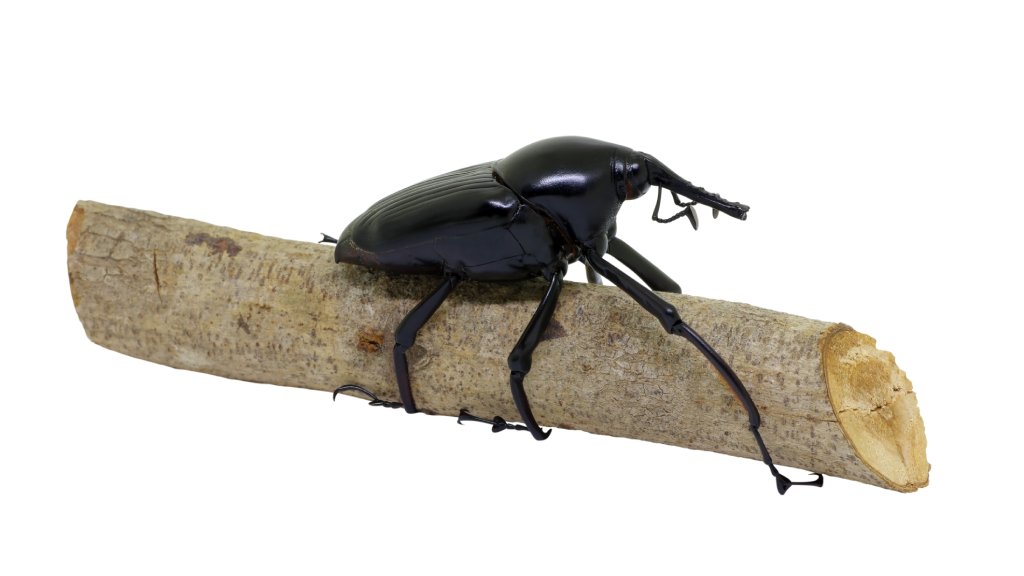South American Palm Weevil: Identification & Control Methods
South American palm weevils are small bugs that can cause big damage.


The South American palm weevil is a very small bug that has the potential to cause very big problems. Native to Mexico, Central America, and South America, this invasive weevil eats the foliage of many different kinds of palm trees, while its larvae eat the heart of the palms, causing much damage.
What Is the South American Palm Weevil?
South American palm weevils are small insects, some 1.5 to 2 inches (4 to 5 cm) long as adults. They have a hard black shell with a small, round head and a long, curved mouthpiece. These weevils carry the scientific name of Rhynchophorus palmarum, and present an important threat to the palm industries in California and Texas.
The adult uses its mouthpiece to eat parts of the palm host, but the primary threats to the palm come from the larvae. A female palm weevil lays eggs in the host tree, and as they develop into larvae, they eat into the trees to consume the palm heart, severely damaging and often killing the palm.
There is a second major issue with the South America palm weevil in California and Texas. This is the fact that the larvae can carry and transmit the nematode, Bursaphelenchus cocophilus, resulting in the red-ring disease in coconut and oil palms. Palm trees infected with red ring disease die within 2 to 4 months.
South American Palm Weevil Life Cycle
South American palm weevils begin life as eggs. A female adult lays eggs - sometimes as many as 700 - on the host palms. The eggs hatch in five days or less into larvae, which feed on live plant tissues, often the heart of the palm.
The larval period takes eight weeks and is followed by the prepupal stage that takes up to 17 days. During the prepupal stage, larvae create cocoons from palm fibers. This is followed by the pupal stage that lasts for up to three weeks before emerging as adults. Adult females can live for seven weeks while males can live a week longer. During this time, the female lays eggs.
Identifying South American Palm Weevil Damage
If your palms are damaged by the South American palm weevil, it isn’t likely to escape your notice. The palm leaves turn yellow and emerging leaves dry out and die. The leaf death occurs from the crown and moves down, causing the center of the crown to droop and collapse.
Gardening tips, videos, info and more delivered right to your inbox!
Sign up for the Gardening Know How newsletter today and receive a free copy of our e-book "How to Grow Delicious Tomatoes".
Larvae dig out galleries in the leaves and stems. These are very evident when the palm is heavily infested. Damage is enormous and rapid. An adult coconut palm can be killed in just six weeks by as few as 30 hungry larvae. Infested trees emit a strong, unpleasant odor.
The deadly red ring disease causes characteristic “red rings” in the interior of the tree stem. Trees infected usually die within four months of first showing symptoms.
South American Palm Weevil Control
Once a palm tree is infested with South American palm weevils, its prognosis is poor. No South American palm weevil treatment has been proven effective in saving the tree. Insecticides exist and can sometimes work against this pest if used early enough but scientists do not feel confident about what dose will work at what time. The insecticide “Endrin” has shown some promise in controlling palm weevil populations, but it is extremely expensive..
Some tout the benefits of South American palm weevil traps. While these can be useful in reducing weevil populations, they are rarely effective in saving an infected palm tree.
Note: Any recommendations pertaining to the use of chemicals are for informational purposes only. Chemical control should only be used as a last resort, as organic approaches are safer and more environmentally friendly.

Teo Spengler is a master gardener and a docent at the San Francisco Botanical Garden, where she hosts public tours. She has studied horticulture and written about nature, trees, plants, and gardening for more than two decades. Her extended family includes some 30 houseplants and hundreds of outdoor plants, including 250 trees, which are her main passion. Spengler currently splits her life between San Francisco and the French Basque Country, though she was raised in Alaska, giving her experience of gardening in a range of climates.
-
 Looking For Plants To Give You The Soft And Fuzzies? Try These 5 Fuzzy Leaf Plant Options
Looking For Plants To Give You The Soft And Fuzzies? Try These 5 Fuzzy Leaf Plant OptionsLovers of texture, drama, silver foliage and tactile plants will adore these special sensory garden additions. These fuzzy leaf plant options will leave you all aglow
By Susan Albert
-
 Get Ready For A Summer Of Hummers! Grow These Full Sun Hummingbird Plants and Flowers
Get Ready For A Summer Of Hummers! Grow These Full Sun Hummingbird Plants and FlowersIf you’re lucky enough to enjoy a sunny backyard, make sure you are maxing out on your pollinator opportunities and grow these full sun hummingbird plants and flowers
By Tonya Barnett